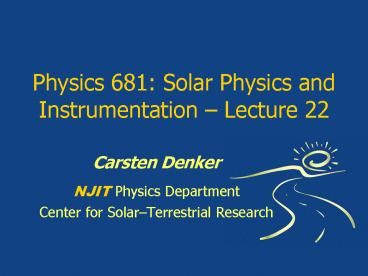Physics 681: Solar Physics and Instrumentation Lecture 22 PowerPoint PPT Presentation
1 / 15
Title: Physics 681: Solar Physics and Instrumentation Lecture 22
1
Physics 681 Solar Physics and Instrumentation
Lecture 22
- Carsten Denker
- NJIT Physics Department
- Center for SolarTerrestrial Research
2
The Magnetic Force
- Lorentz force (non-relativistic Ohms law
magnetohydrodynamic approximation) - The volume force can be divided into a magnetic
pressure gradient and a magnetic tension - Magnetic flux tube applies a lateral pressure to
the gas into which it is embedded - Typical pressure 104 Pa can be balanced by B
0.15 T - In sunspots we see at deeper layer ? 2 ? 104 Pa ?
B 0.3 T - Magnetic tension is the tendency of lines of
force to shorten themselves ?
restoring force to perturbations
3
Magnetic Flux Tubes
- Converging plasma motion is capable of
concentrating magnetic flux - Cellular flows (granulation, mesogranulation,
supergranulation, and giant cells) - Kinematic approximation (the flow v is given,
the Lorentz force is neglected) - 2D, stationary flow consisting of rolls
- Magnetic Reynolds number Rm ul / ? 250
- Boundary conditions field is vertical at all
times at all boundaries - Field lines become deformed ? diffusion term in
the induction equation is no longer negligible ?
field line reconnection ? magnetic flux is
expelled from the interior and
accumulated in sheets near the cell edges
4
Clark and Johnson (1967)
Galloway and Weiss (1981)
5
- Steady state time scale of field decay d 2 / ?
equals time scale of advection l / u - Final flux after field concentration
- Field amplification is rapid l / u (turnover
time) - Expulsion of flux is slower 5( l / u ) and
depends on Rm - Flux sheets may exist (chain-like crinkles)
- Equipartition between kinetic and magnetic energy
densities (dynamic regime) - Regions of motion and regions of fields mutually
exclude each other - Critical flux
- Field BP corresponds to an equilibrium between
magnetic and gas pressure
6
Galloway and Weiss (1981)
7
- Surface density ? 3 ? 10-4 kg/m3, velocity of
granules u 2.0 km/s ? equipartition field Be
0.04 T - Observed fields are a factor 3 larger ?
convective collapse (convective instability in
the presence of a magnetic field) - Stable flux tube exist for a minimum field of 0.1
T capable of suppressing the convective
instability - The magnetic field is very weak for the major
fraction of the solar surface - Locally stronger fields of gt0.1 T in flux tubes
- Solar magnetic fields are intermittent
- Pores are sunspots lacking a penumbra (B 0.15
T, lifetime 1 day, size 5
arcsec) - Magnetic knots (B 0.1-0.2 T, line gaps in
spectra, lifetime 1 hour, size 1-2 arcsec,
IR observations, abundant near sunspots, 10
knots per 100 granules, knots have predominantly
the opposite field of sunspots, flux is balanced) - Unresolved fields ? filling factor (d 100-200
km)
8
http//www.kis.uni-freiburg.de/steiner/
9
Lin and Rimmele (1999)
10
Wang et al. (1998)
11
http//nsosp.nso.edu/dst/images/fill1.gif
12
(No Transcript)
13
(No Transcript)
14
Langhans et al. (2002)
15
http//dotdb.phys.uu.nl/DOT/Showpiece/movies.html

